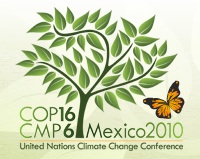Lead Up to Cancun - What's in Store?
 As the UN’s Framework
As the UN’s FrameworkConvention on Climate Change’s 16th Conference of the Parties (
- Dec. 10 in Cancun nears, observers scrutinizing international
action and inaction since COP15 are looking to predict how the
event may unfold.
COP15’s hot button issues of maximum temperature rise and
reduction targets remain largely unaddressed. The
target=”_blank”>2010 World Energy Outlook report predicts that
emissions under COP15 GHG targets will still cause a notable rise
in global CO2 forecast to surpass the international temperature
rise target of 2°C.
The US, a critical player, is coming to the table with piecemeal
climate change bills unlikely to satisfy Copenhagen Accord
commitments. Canada is in the same position.
Internationally, progress on GHG mitigation has proven to be
more successful. China is increasingly
target=”_blank”>expected to bind its currently non-binding
carbon intensity reduction target, and Brazil has effectively met
its 2020 reduction target. The
target=”_blank”>EU projects achieving its Kyoto target by 2020,
and Japan
target=”_blank”>revealed its plan to develop an emissions
trading scheme by April, 2013.
But with the two main sticking points in
COP15 still unresolved, what can be expected to be tackled in
Cancun?
In a pre-COP16 ministerial meeting of 50 countries in early
Nov., discussions focused on priority elements of climate change
mitigation: monitoring, reporting, and verification; finance,
technology, and capacity building; the Kyoto protocol; and
adaptation.
Financing commitments of $30 billion for the 2010-2012 period
and $100B by 2020 outlined in the Copenhagen Accord are likely to
be a particularly strong area of focus as these are considered a
critical post-Copenhagen tool in rebuilding the relationship
between developing and developed nations.
The outlook for success in at least some of these areas is
promising. The US has developed clean energy agreements with India.
China has signed an environmental cooperation memorandum of
understanding with Canada. Many nations have outlined their
2010-2012 commitments, including $400M by Canada (
target=”_blank”>see Delphi’s previous coverage) and $1B by the
US, however the proportion of assistance being offered through
loans, as opposed to grants, has surfaced as an area of
concern.
Canada, the US, and Mexico have
target=”_blank”>proposed using COP16 to link the Kyoto
Protocol with the Montreal Protocol in efforts to reduce
hydrofluorocarbon (HFC) emissions (however, the Montreal Protocol
does limit the use of chlorinated HCFCs). HFCs are managed under
Kyoto, which the US has not ratified, but not the Montreal
Protocol, which it has.
HFCs have emerged as a substitute for the ozone-depleting
substances limited by the Montreal Protocol but are GHGs. Adapting
the Montreal Protocol to address HFC emissions, and linking it to
Kyoto, would apply binding targets to the US without requiring it
to ratify Kyoto.
Pre-COP preparations have laid the framework for consensus on
priorities for analysis. While a binding treaty is not expected,
COP16 participants can nevertheless promote some successes and
advance global action on climate change.
This article first appeared in the November edition of
The Delphi Group’s
target=”_blank”>Climate Change Policy & Sustainability
Update and is reprinted here with the kind permission of the
author.
You can return to the main Market News page, or press the Back button on your browser.

